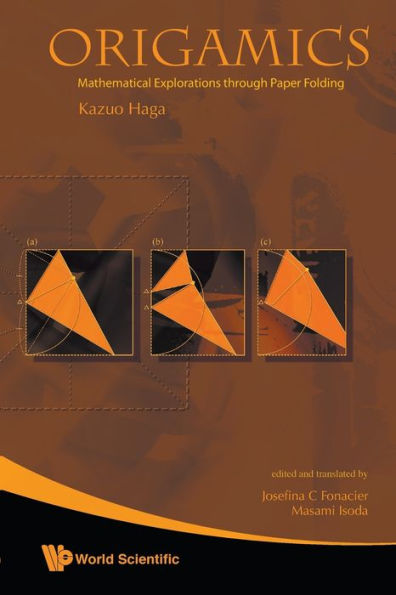Table of Contents
Introduction v
Until the Publication of the English Edition vii
Acknowledgments ix
Preface for the English Edition xi
1 A Point Opens the Door to Origamics 1
1.1 Simple Questions About Origami 1
1.2 Constructing a Pythagorean Triangle 2
1.3 Dividing a Line Segment into Three Equal Parts Using no Tools 5
1.4 Extending Toward a Generalization 8
2 New Folds Bring Out New Theorems 11
2.1 Trisecting a Line Segment Using Haga's Second Theorem Fold 11
2.2 The Position of Point F is Interesting 14
2.3 Some Findings Related to Haga's Third Theorem Fold 17
3 Extension of the Haga's Theorems to Silver Ratio Rectangles 21
3.1 Mathematical Adventure by Folding a Copy Paper 21
3.2 Mysteries Revealed from Horizontal Folding of Copy Paper 25
3.3 Using Standard Copy Paper with Haga's Third Theorem 30
4 X-Lines with Lots of Surprises 33
4.1 We Begin with an Arbitrary Point 33
4.2 Revelations Concerning the Points of Intersection 35
4.3 The Center of the Circumcircle! 37
4.4 How Does the Vertical Position of the Point of Intersection Vary? 38
4.5 Wonders Still Continue 41
4.6 Solving the Riddle of "1/2" 42
4.7 Another Wonder 43
5 "Intrasquares" and "Extrasquares" 45
5.1 Do Not Fold Exactly into Halves 46
5.2 What Kind of Polygons Can You Get? 46
5.3 How do You Get a Triangle or a Quadrilateral? 48
5.4 Now to Making a Map 49
5.5 This is the "Scientific Method" 53
5.6 Completing the Map 53
5.7 We Must Also Make the Map of the Outer Subdivision 55
5.8 Let Us Calculate Areas 57
6 A Petal Pattern from Hexagons? 59
6.1 The Origamics Logo 59
6.2 Folding a Piece of Paper by Concentrating the Four Vertices at One Point 60
6.3 Remarks onPolygonal Figures of Type n 63
6.4 An Approach to the Problem Using Group Study 64
6.5 Reducing the Work of Paper Folding; One Eighth of the Square Will Do 65
6.6 Why Does the Petal Pattern Appear? 66
6.7 What Are the Areas of the Regions? 70
7 Heptagon Regions Exist? 71
7.1 Review of the Folding Procedure 71
7.2 A Heptagon Appears! 73
7.3 Experimenting with Rectangles with Different Ratios of Sides 74
7.4 Try a Rhombus 76
8 A Wonder of Eleven Stars 77
8.1 Experimenting with Paper Folding 77
8.2 Discovering 80
8.3 Proof 82
8.4 More Revelations Regarding the Intersections of the Extensions of the Creases 85
8.5 Proof of the Observation on the Intersection Points of Extended Edge-to-Line Creases 89
8.6 The Joy of Discovering and the Excitement of Further Searching 91
9 Where to Go and Whom to Meet 93
9.1 An Origamics Activity as a Game 93
9.2 A Scenario: A Princess and Three Knights? 93
9.3 The Rule: One Guest at a Time 94
9.4 Cases Where no Interview is Possible 97
9.5 Mapping the Neighborhood 97
9.6 A Flower Pattern or an Insect Pattern 99
9.7 A Different Rule: Group Meetings 99
9.8 Are There Areas Where a Particular Male can have Exclusive Meetings with the Female? 101
9.9 More Meetings through a "Hidden Door" 103
10 Inspiraration of Rectangular Paper 107
10.1 A Scenario: The Stern King of Origami Land 107
10.2 Begin with a Simpler Problem: How to Divide the Rectangle Horizontally and Vertically into 3 Equal Parts 108
10.3 A 5-parts Division Point; the Pendulum Idea Helps 111
10.4 A Method for Finding a 7-parts Division Point 115
10.5 The Investigation Continues: Try the Pendulum Idea on the 7-parts Division Method 117
10.6 The Search for 11-parts and 13-parts Division Points 120
10.7 Another Method for Finding 11-parts and 13-parts Division Points 122
10.8 Continue the Trend of Thought: 15-parts and 17-parts Division Points 125
10.9 Some Ideas related to the Ratios for Equal-parts Division based on Similar Triangles 130
10.10 Towards More Division Parts 134
10.11 Generalizing to all Rectangles 134




